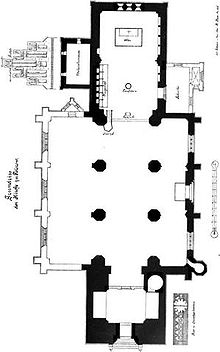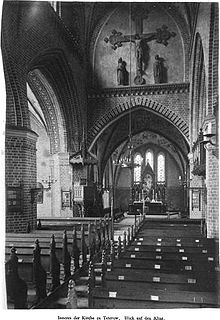Teterow town church
The town church St. Peter and Paul is a typical building of the north German brick Gothic . It is located in the Mecklenburg town of Teterow and is the church of the parish Teterow in the Rostock provost in the Mecklenburg parish of the Evangelical Lutheran Church in Northern Germany ( Northern Church ).
Building description
The oldest part of the church is the early Gothic choir, built in 1280 . The second building of Rostock's Marienkirche , built between 1265 and 1279, is seen as a direct model . The choir gable shows a group of three windows, as is not uncommon in early Gothic brick (and also field stone) churches southwards as far as the Mark Brandenburg and westwards as far as the province of Groningen . The side walls each have two slender pointed arch windows. The two choir yokes are heavily ribbed ribbed vaults based on the Westphalian model.
A little later, the sacristy was built on the north side, but initially without the (also medieval) ornate gable.
According to dendrochronological findings, the nave was built in 1310. Its cross-section is somewhat asymmetrical, on the south side it is a supporting basilica with windowless tall nave walls, on the north side it is a basilica with cantilever windows . An ad hoc decision by the builders is assumed to be the cause, which is nothing unusual in medieval church building. The north aisle, however, was replaced by a larger one in 1877–1880, with lush neo-Gothic transverse gables. The southern sacristy was built at the same time.
The square, almost 40 m high west tower, not yet included in the original concept, was built in the first half of the 15th century, the uppermost parts according to Dendrobefund 1450.
Furnishing
In the church there are valuable medieval frescoes from the 14th century, especially in the choir vault.
The carved main altar (Coronation Altar), designed as a double-winged altar, shows a Coronation of Mary when fully open and the twelve apostles with Paul and Stephen as well as 17 other saints in a narrow strip below. When the first pair of wings is closed, a cycle of paintings on the Passion appears in 16 individual depictions, which is attributed to the master of the Rostock Three Kings Altar. The paintings on the outer wings, which become visible when the altar is completely closed, are lost. The altar is now on the west wall of the north aisle.
Above the entrance to the choir is a large triumphal cross : a crucifix framed by the figures of the Virgin Mary and the Evangelist John. The cross is decorated with the four evangelist symbols at the four ends and with large leaves at the edges.
There is a picture of a radiant Madonna on one side wall. A baptismal font ( fifth ) made of limestone stands in front of the chancel in the central nave . Remains of a pulpit from the Renaissance period are now in the tower hall. The altar, pulpit and benches date from the neo-Gothic renewal of 1877/80. The altarpiece is probably a representation of the resurrection, a copy after Bernhard Plockhorst .
A memorial plaque for the parishioners who died in the First World War has been attached to the east wall of the north aisle since the 1920s. Above it is a cross for the victims of the Second World War.
Since November 9, 1990, a memorial by a Teterow blacksmith has stood in the church for the time of reunification . At the suggestion of Pastor Martin Kuske at the time, it was made from the steel of an armored personnel carrier and bears the biblical quote " Swords to Plowshares ", which was used by the peace movement in the GDR. A support association was founded to preserve the church.
organ
Paul Schmidt built a new organ in 1789 . In 1891 it was replaced by a new work by Heinrich Schlag & Söhne ; the old case was retained. Since 1991, behind the historical organ prospectus, there has been a new building by the organ building company Mecklenburger Orgelbau (Wolfgang Nussbücker) with a total of 30 stops on two manuals and pedal.
Today's organ has the following disposition :
|
|
|
||||||||||||||||||||||||||||||||||||||||||||||||||||||||||||||||
- Pairing : I / P, II / P
The “Teterower Pike” (a little bell based on a Teterower story) and a chirping bird were installed as additional side trains.
Clergy
- Felix Fiedler (1633–1707), pastor at the town church from 1661 to 1704 and founder
- Martin Kuske (1940–1995), pastor at the Teterow town church from 1978 to 1994
See also
literature
- Detlef Krohn: The wall painting in the choir vault of the town church St. Peter and Paul in Teterow and its restoration (in KulturERBE in Mecklenburg-Vorpommern, Volume 3, year 2010, edited by the Department of Archeology and Monument Preservation in the State Office for Culture and Monument Preservation , D. Jantzen and K. Winands), with the current state of research on building history
- Georg Christian Friedrich Lisch : The church to Teterow. In: Yearbooks of the Association for Mecklenburg History and Archeology Volume 12, Schwerin, 1847 hs-wismar.de ( Memento from January 6, 2013 in the web archive archive.today ).
- Georg Christian Friedrich Lisch : The church to Teterow. In: Yearbooks of the Association for Mecklenburg History and Archeology Volume 42, Schwerin, 1877 hs-wismar.de ( Memento from September 1, 2004 in the Internet Archive ).
- Friedrich Schlie : The art and historical monuments of the Grand Duchy of Mecklenburg-Schwerin. Volume 5: The district courts of Teterow, Malchin, Stavenhagen, Penzlin, Waren, Malchow and Röbel. Schwerin 1902, pp. 8-20 ( books.google.com ).
- Verena Friedrich, Martin Kuske: Teterow. Kunstverlag Peda, Passau 1993 (Peda-Kunstführer No. 81/1993), ISBN 3-927296-88-0 .
Web links
- Literature about the town church Teterow in the state bibliography MV
- Parish Teterow on the pages of the church district Güstrow
Individual evidence
- ↑ Dehio-Handbuch Mecklenburg-Vorpommern, 2016, ISBN 978-3-422-03128-9 , pp. 694-696
- ↑ Places in MV: Teterow ( Memento from November 19, 2010 in the Internet Archive )
- ↑ List of friends' associations ( Memento from August 14, 2010 in the Internet Archive ) on kirche-mv.de
Coordinates: 53 ° 46 ′ 24.8 " N , 12 ° 34 ′ 28.3" E





